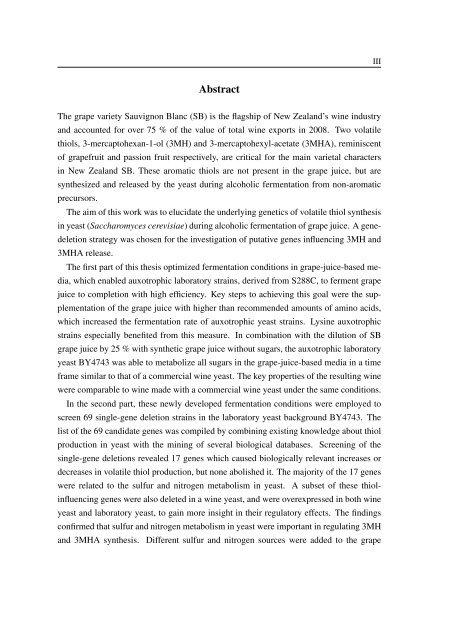Identification of yeast genes involved in Sauvignon Blanc aroma ...
Identification of yeast genes involved in Sauvignon Blanc aroma ...
Identification of yeast genes involved in Sauvignon Blanc aroma ...
Create successful ePaper yourself
Turn your PDF publications into a flip-book with our unique Google optimized e-Paper software.
IIIAbstractThe grape variety <strong>Sauvignon</strong> <strong>Blanc</strong> (SB) is the flagship <strong>of</strong> New Zealand’s w<strong>in</strong>e <strong>in</strong>dustryand accounted for over 75 % <strong>of</strong> the value <strong>of</strong> total w<strong>in</strong>e exports <strong>in</strong> 2008. Two volatilethiols, 3-mercaptohexan-1-ol (3MH) and 3-mercaptohexyl-acetate (3MHA), rem<strong>in</strong>iscent<strong>of</strong> grapefruit and passion fruit respectively, are critical for the ma<strong>in</strong> varietal characters<strong>in</strong> New Zealand SB. These <strong>aroma</strong>tic thiols are not present <strong>in</strong> the grape juice, but aresynthesized and released by the <strong>yeast</strong> dur<strong>in</strong>g alcoholic fermentation from non-<strong>aroma</strong>ticprecursors.The aim <strong>of</strong> this work was to elucidate the underly<strong>in</strong>g genetics <strong>of</strong> volatile thiol synthesis<strong>in</strong> <strong>yeast</strong> (Saccharomyces cerevisiae) dur<strong>in</strong>g alcoholic fermentation <strong>of</strong> grape juice. A genedeletionstrategy was chosen for the <strong>in</strong>vestigation <strong>of</strong> putative <strong>genes</strong> <strong>in</strong>fluenc<strong>in</strong>g 3MH and3MHA release.The first part <strong>of</strong> this thesis optimized fermentation conditions <strong>in</strong> grape-juice-based media,which enabled auxotrophic laboratory stra<strong>in</strong>s, derived from S288C, to ferment grapejuice to completion with high efficiency. Key steps to achiev<strong>in</strong>g this goal were the supplementation<strong>of</strong> the grape juice with higher than recommended amounts <strong>of</strong> am<strong>in</strong>o acids,which <strong>in</strong>creased the fermentation rate <strong>of</strong> auxotrophic <strong>yeast</strong> stra<strong>in</strong>s. Lys<strong>in</strong>e auxotrophicstra<strong>in</strong>s especially benefited from this measure. In comb<strong>in</strong>ation with the dilution <strong>of</strong> SBgrape juice by 25 % with synthetic grape juice without sugars, the auxotrophic laboratory<strong>yeast</strong> BY4743 was able to metabolize all sugars <strong>in</strong> the grape-juice-based media <strong>in</strong> a timeframe similar to that <strong>of</strong> a commercial w<strong>in</strong>e <strong>yeast</strong>. The key properties <strong>of</strong> the result<strong>in</strong>g w<strong>in</strong>ewere comparable to w<strong>in</strong>e made with a commercial w<strong>in</strong>e <strong>yeast</strong> under the same conditions.In the second part, these newly developed fermentation conditions were employed toscreen 69 s<strong>in</strong>gle-gene deletion stra<strong>in</strong>s <strong>in</strong> the laboratory <strong>yeast</strong> background BY4743. Thelist <strong>of</strong> the 69 candidate <strong>genes</strong> was compiled by comb<strong>in</strong><strong>in</strong>g exist<strong>in</strong>g knowledge about thiolproduction <strong>in</strong> <strong>yeast</strong> with the m<strong>in</strong><strong>in</strong>g <strong>of</strong> several biological databases. Screen<strong>in</strong>g <strong>of</strong> thes<strong>in</strong>gle-gene deletions revealed 17 <strong>genes</strong> which caused biologically relevant <strong>in</strong>creases ordecreases <strong>in</strong> volatile thiol production, but none abolished it. The majority <strong>of</strong> the 17 <strong>genes</strong>were related to the sulfur and nitrogen metabolism <strong>in</strong> <strong>yeast</strong>. A subset <strong>of</strong> these thiol<strong>in</strong>fluenc<strong>in</strong>g<strong>genes</strong> were also deleted <strong>in</strong> a w<strong>in</strong>e <strong>yeast</strong>, and were overexpressed <strong>in</strong> both w<strong>in</strong>e<strong>yeast</strong> and laboratory <strong>yeast</strong>, to ga<strong>in</strong> more <strong>in</strong>sight <strong>in</strong> their regulatory effects. The f<strong>in</strong>d<strong>in</strong>gsconfirmed that sulfur and nitrogen metabolism <strong>in</strong> <strong>yeast</strong> were important <strong>in</strong> regulat<strong>in</strong>g 3MHand 3MHA synthesis. Different sulfur and nitrogen sources were added to the grape














